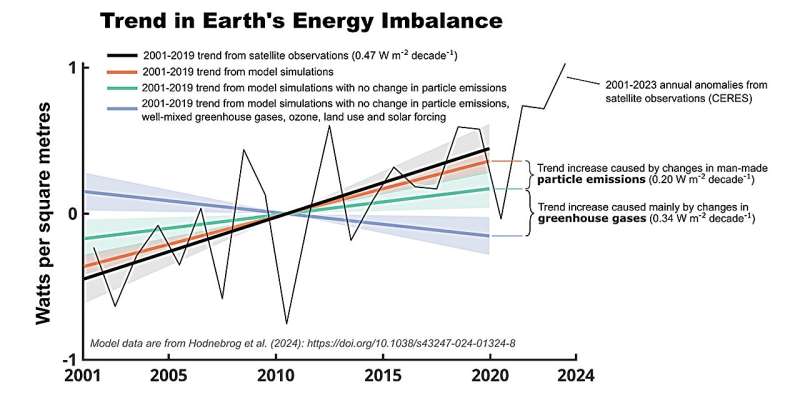
Study presents evidence that recent reductions in aerosol emissions create an additional warming effect (Image Credit: Phys.org)

Recent reductions in emissions of tiny particles, the major cause of air pollution globally, have led to more heat in the Earth’s climate system. This is shown in a new international study led by CICERO and published in Communications Earth & Environment.
Satellite measurements clearly show that more heat is entering the Earth’s atmosphere from the sun compared to the amount of terrestrial energy escaping to space. This so-called Earth energy imbalance leads to accumulation of heat and warming of the Earth’s surface.
It is well known that man-made emissions of CO2 and other greenhouse gases have been the major cause of global warming in recent decades, and that emissions of particles have masked part of this warming. Most of the particles, especially sulfate, reflect sunlight and therefore act to cool the planet. In the last couple of decades, however, this cooling effect has reversed and now contributes to a warming due to extensive measures to improve air quality in many regions worldwide.
In the study, the researchers performed simulations using the latest generation global climate models and compared their results to satellite measurements of the Earth’s energy imbalance trend over the 2001–2019 period.
The authors found that the recent reductions in man-made particle emissions needed to be accounted for in order for the models to reasonably match the satellite measurements (see figure above; black vs. orange line). When the authors assumed that the particle emissions did not change over the time period (green line), the simulated heating of the Earth was considerably reduced.
“Our study makes novel use of models and observations to explain why the Earth’s energy imbalance is increasing so much. This is of utmost importance because there has been a lot of debate about what is causing the observed doubling in imbalance, which is what drives global warming, sea level rise, extreme weather events, melting of snow and ice, and other aspects of climate change,” explains senior researcher at CICERO Center for International Climate Research, Øivind Hodnebrog, who is the lead author of the study.
“Our study underscores the importance of having continuous satellite measurements of the Earth’s energy budget,” says senior technologist at NASA, Norman Loeb, who is co-author of the study.
Air pollution is a major health issue causing millions of excess deaths globally, and it is important to clean up the air. Nevertheless, air quality improvements come at a cost. When removing emissions of reflecting particles, the particles and their cooling effect disappear in the order of days. In the case of CO2 and other long-lived greenhouse gases, however, the warming gases stay in the atmosphere for centuries after they are emitted.
Another co-author of the study, research director Gunnar Myhre at CICERO, says that “the additional warming effect that comes from removal of cooling particles is something researchers have anticipated would happen for a long time, and does not come as a surprise in that sense, but now we have the evidence. Also, the strong impact that the particle emission reductions had on adding to the Earth’s energy imbalance in the past two decades was an eye-opener.”
Hodnebrog says, “Continued reductions of particle emissions may lead to an accelerated surface temperature warming already in this decade.”
More information:
Øivind Hodnebrog et al, Recent reductions in aerosol emissions have increased Earth’s energy imbalance, Communications Earth & Environment (2024). DOI: 10.1038/s43247-024-01324-8
Journal information:
Communications Earth & Environment
Provided by
Centre for International Climate and Environmental Research (CICERO)
Study presents evidence that recent reductions in aerosol emissions create an additional warming effect (2024, April 8)
retrieved 9 April 2024
from https://phys.org/news/2024-04-evidence-reductions-aerosol-emissions-additional.html
part may be reproduced without the written permission. The content is provided for information purposes only.





